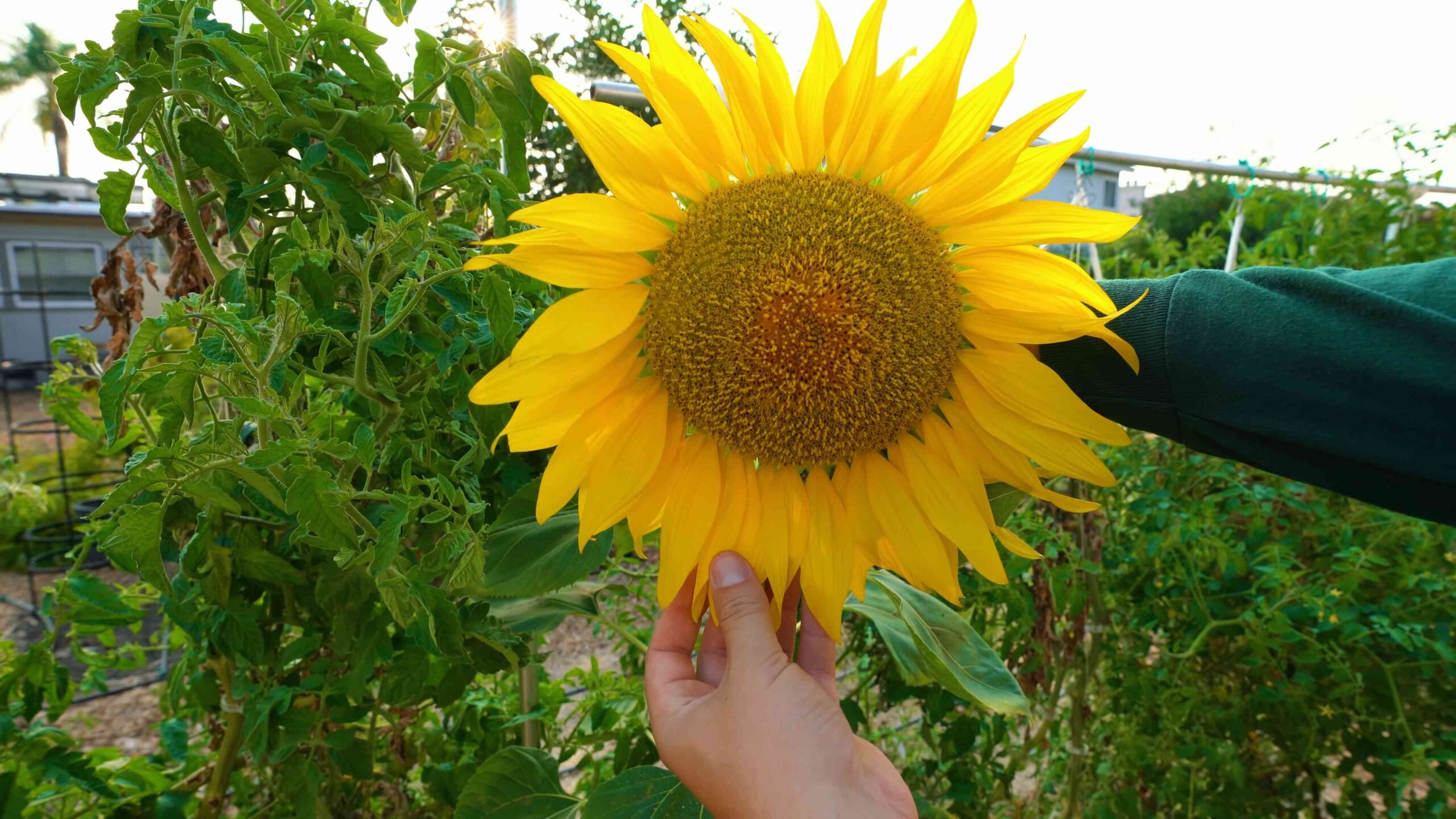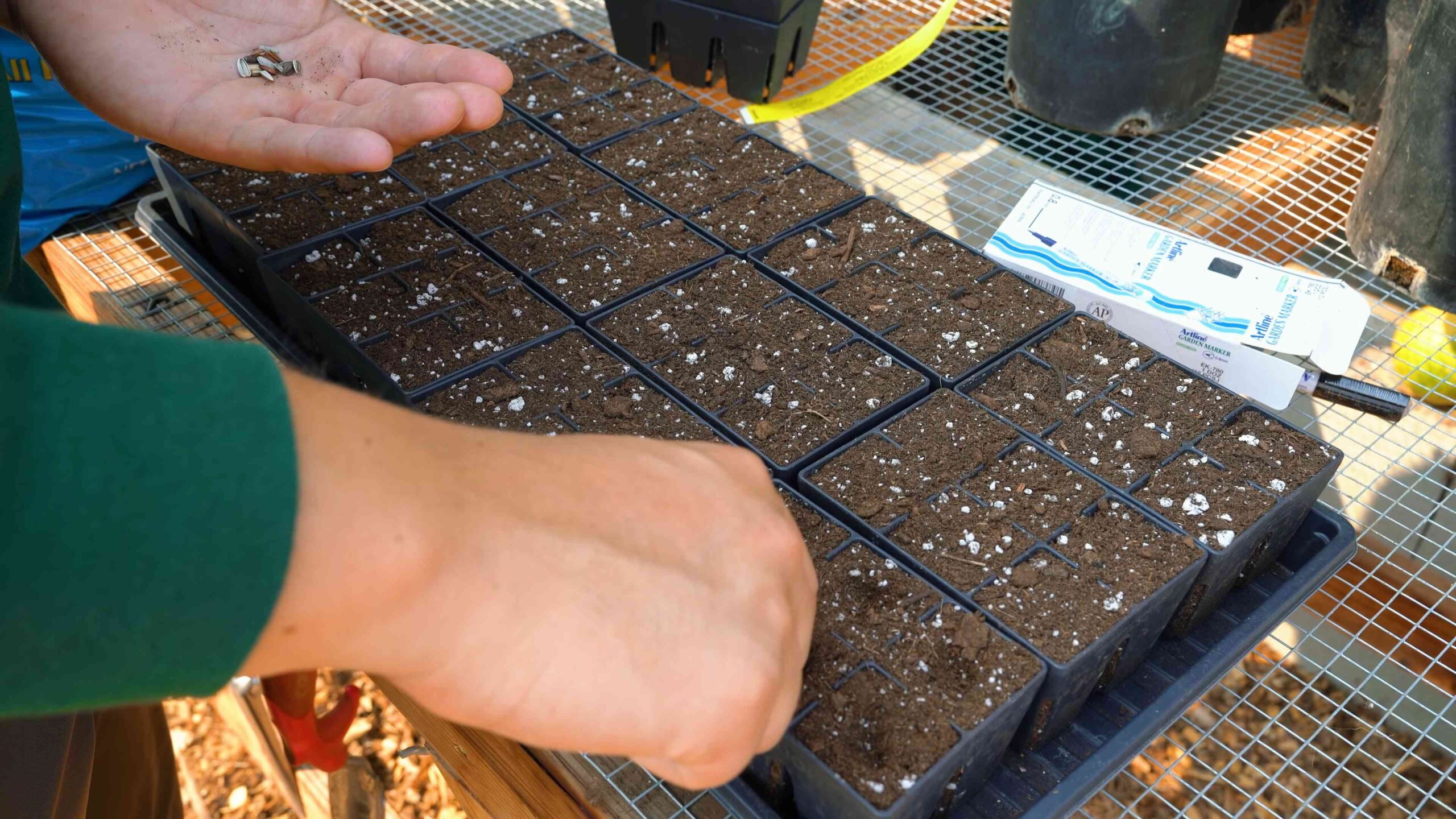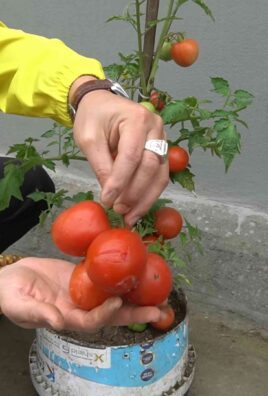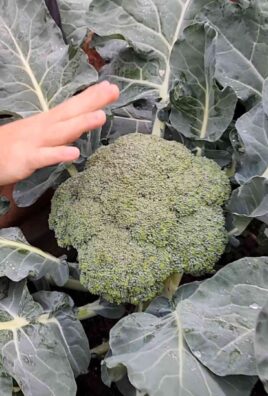Grow Sunflowers at Home and bring a burst of sunshine right to your backyard! Imagine waking up every morning to the sight of these towering beauties, their faces turned towards the sun, filling your garden with vibrant color and attracting delightful pollinators. Sounds dreamy, right? Well, it’s easier than you think!
Sunflowers have a rich history, dating back to North America where they were cultivated by indigenous peoples for food, oil, and even medicinal purposes. They’ve since spread across the globe, becoming a symbol of joy, warmth, and longevity in many cultures. But beyond their symbolic meaning, sunflowers offer a practical and rewarding gardening experience.
Let’s be honest, gardening can sometimes feel intimidating, especially if you’re a beginner. But growing sunflowers is surprisingly straightforward, and I’m here to share some simple DIY tricks and hacks that will guarantee you a stunning display. Whether you have a sprawling garden or just a small balcony, you can grow sunflowers at home. I’ll guide you through everything from choosing the right variety to protecting your precious plants from pests, ensuring you have a thriving sunflower patch that will be the envy of the neighborhood. So, grab your gardening gloves, and let’s get started!

Grow Your Own Sunshine: A Beginner’s Guide to Growing Sunflowers at Home
Okay, sunflower lovers, let’s get our hands dirty! I’m going to walk you through everything you need to know to grow those glorious, towering sunflowers right in your own backyard (or even in a pot!). Trust me, it’s easier than you think, and the reward of seeing those bright yellow faces turn towards the sun is absolutely worth it.
Choosing Your Sunflower Variety
Before we even think about soil, let’s talk sunflowers. There are SO many varieties, from the classic giants to dwarf varieties perfect for containers. Here’s a quick rundown to help you choose:
* **Giant Sunflowers:** These are the showstoppers! Think ‘Mammoth,’ ‘Russian Mammoth,’ or ‘Titan.’ They can grow up to 12 feet tall (or even taller!) and produce huge, heavy heads. Keep in mind they need lots of space and strong support.
* **Medium-Sized Sunflowers:** These are a great compromise if you want some height but don’t have the space for giants. ‘Lemon Queen’ (with its beautiful lemon-yellow petals) and ‘Autumn Beauty’ (with its mix of autumnal colors) are popular choices.
* **Dwarf Sunflowers:** Perfect for containers or small gardens! ‘Teddy Bear’ (fluffy, double petals) and ‘Little Becka’ (red and yellow bi-color) are adorable options. They typically stay under 3 feet tall.
* **Colored Sunflowers:** Don’t think sunflowers are just yellow! You can find varieties in shades of red, orange, brown, and even almost black. ‘Chocolate Cherry’ and ‘Velvet Queen’ are stunning examples.
* **Branching Sunflowers:** Most sunflowers produce a single flower on a tall stalk, but branching varieties produce multiple smaller flowers on side branches. This gives you a longer bloom time and more flowers to enjoy!
Consider your space, your desired height, and your favorite colors when choosing your sunflower seeds. You can find seeds at most garden centers or online.
Getting Started: Planting Your Sunflower Seeds
Now for the fun part! Let’s get those seeds in the ground.
1. **Timing is Key:** Sunflowers are warm-weather plants, so you need to wait until the danger of frost has passed. I usually wait until about two weeks after the last expected frost in my area. The soil temperature should be at least 50°F (10°C) for optimal germination. You can start seeds indoors 2-3 weeks before the last frost if you want a head start, but sunflowers don’t love being transplanted, so direct sowing is usually best.
2. **Choosing the Right Location:** Sunflowers need at least 6-8 hours of direct sunlight per day. Choose a spot in your garden that gets plenty of sun. Also, consider the mature height of your chosen variety. You don’t want to plant them where they’ll shade out other plants.
3. **Preparing the Soil:** Sunflowers aren’t too picky about soil, but they do prefer well-drained soil that’s rich in organic matter. Before planting, amend the soil with compost or well-rotted manure. This will provide nutrients and improve drainage. I like to dig in about 2-3 inches of compost.
4. **Planting the Seeds:** Sow the seeds about 1 inch deep and 6 inches apart. If you’re planting giant sunflowers, you might want to space them further apart (12-18 inches) to give them plenty of room to grow. Cover the seeds with soil and gently water them in.
5. **Watering:** Keep the soil consistently moist until the seeds germinate. This usually takes about 7-10 days. Don’t overwater, though, as this can cause the seeds to rot.
6. **Thinning:** Once the seedlings emerge and have a few sets of true leaves, thin them out to the desired spacing. This means removing some of the seedlings so that the remaining plants have enough room to grow. Choose the strongest, healthiest-looking seedlings to keep.
Caring for Your Sunflowers: From Seedling to Bloom
Okay, your sunflowers are up and growing! Now it’s time to make sure they thrive.
1. **Watering:** Sunflowers need regular watering, especially during hot, dry weather. Water deeply and infrequently, rather than shallowly and frequently. This encourages deep root growth. I usually water my sunflowers about once a week, unless it’s been particularly hot and dry.
2. **Fertilizing:** Sunflowers are heavy feeders, so they benefit from regular fertilization. Use a balanced fertilizer (like 10-10-10) every few weeks. You can also side-dress with compost or well-rotted manure.
3. **Weeding:** Keep the area around your sunflowers free of weeds. Weeds compete with sunflowers for water and nutrients. I like to hand-weed regularly.
4. **Staking:** Giant sunflowers can get top-heavy, especially when the flower heads are full of seeds. Stake them to prevent them from falling over. Use sturdy stakes and tie the sunflower stalks to the stakes with soft twine.
5. **Pest Control:** Sunflowers are generally pest-resistant, but they can be susceptible to certain pests, such as aphids, sunflower beetles, and grasshoppers. Inspect your plants regularly and take action if you see any pests. You can usually control aphids with a strong spray of water. For other pests, you may need to use an insecticidal soap or other organic pesticide.
6. **Disease Prevention:** Sunflowers can also be susceptible to certain diseases, such as powdery mildew and rust. To prevent these diseases, make sure your plants have good air circulation and avoid overhead watering. If you see signs of disease, remove the affected leaves and treat the plants with a fungicide.
Dealing with Common Sunflower Problems
Even with the best care, you might encounter a few problems along the way. Here’s how to troubleshoot some common sunflower issues:
* **Seeds Not Germinating:** This could be due to several factors, such as cold soil, overwatering, or poor-quality seeds. Make sure the soil temperature is at least 50°F (10°C) before planting. Don’t overwater the seeds. And use fresh, high-quality seeds.
* **Seedlings Being Eaten:** Slugs and snails love to munch on young sunflower seedlings. Protect your seedlings with slug bait or by hand-picking the slugs and snails off the plants.
* **Stalks Falling Over:** This is usually due to the flower heads being too heavy. Stake your sunflowers to prevent them from falling over.
* **Flower Heads Not Developing:** This could be due to lack of sunlight, poor soil, or pests. Make sure your sunflowers are getting at least 6-8 hours of direct sunlight per day. Amend the soil with compost or well-rotted manure. And control any pests that are attacking the plants.
* **Birds Eating the Seeds:** Birds love sunflower seeds! If you want to save the seeds for yourself, you’ll need to protect the flower heads with netting or paper bags.
Harvesting Your Sunflower Seeds
After all your hard work, it’s time to reap the rewards! Here’s how to harvest your sunflower seeds:
1. **When to Harvest:** The best time to harvest sunflower seeds is when the back of the flower head turns brown and the petals start to dry out and fall off. The seeds should be plump and easy to remove from the flower head.
2. **Harvesting the Seeds:** Cut the flower head off the stalk, leaving about 1 foot of stem attached.
3. **Drying the Seeds:** Hang the flower head upside down in a dry, well-ventilated place for several weeks. You can cover the flower head with a paper bag to protect it from birds and insects.
4. **Removing the Seeds:** Once the flower head is completely dry, you can remove the seeds by rubbing the flower head with your hands or a stiff brush.
5. **Storing the Seeds:** Store the seeds in an airtight container in a cool, dry place. They should last for several months.
Enjoy your homegrown sunflower seeds! You can eat them raw, roasted, or use them in baking. You can also save some seeds to plant next year.
Growing Sunflowers in Containers
Don’t have a garden? No problem! You can still grow sunflowers in containers. Here’s what you need to know:
1. **Choose the Right Container:** Select a container that’s at least 12 inches in diameter and 12 inches deep. Make sure the container has drainage holes.
2. **Use a Good-Quality Potting Mix:** Don’t use garden soil in containers. It’s too heavy and doesn’t drain well. Use a good-quality potting mix that’s specifically designed for containers.
3. **Choose Dwarf Varieties:** Dwarf sunflower varieties are best suited for containers. They won’t get too tall and top-heavy.
4. **Planting:** Plant the seeds according to the instructions above.
5. **Watering and Fertilizing:** Water and fertilize your container sunflowers regularly.

Conclusion
So, there you have it! Growing sunflowers at home, from seed to towering bloom, is not only achievable but also incredibly rewarding. This isn’t just about adding a splash of sunshine to your garden; it’s about connecting with nature, witnessing the miracle of growth firsthand, and enjoying the fruits (or rather, seeds!) of your labor. We’ve walked you through the entire process, from selecting the right seeds and preparing the soil to nurturing your seedlings and protecting them from pests.
Why is this DIY trick a must-try? Because it’s accessible to everyone, regardless of gardening experience or space constraints. Whether you have a sprawling backyard or a sunny balcony, you can cultivate these magnificent flowers. It’s also a fantastic educational opportunity for children, teaching them about plant life cycles and the importance of patience. Plus, let’s be honest, who can resist the cheerful sight of a sunflower turning its face towards the sun?
But the beauty of growing sunflowers at home lies in its adaptability. Feel free to experiment with different varieties. Try growing dwarf sunflowers in containers for a more compact display, or opt for branching varieties that produce multiple blooms. You can even explore different color variations, from the classic yellow to vibrant reds and oranges. Consider companion planting to enhance growth and attract beneficial insects. Marigolds, for example, can deter pests, while beans can help fix nitrogen in the soil.
Don’t be afraid to get creative with your sunflower garden! Use them as a natural screen, create a sunflower maze for kids, or simply scatter them throughout your existing flower beds for a touch of whimsy. The possibilities are endless.
We wholeheartedly encourage you to embark on this sunflower-growing adventure. It’s a relatively low-maintenance project with a high return on enjoyment. And remember, the journey is just as important as the destination. Embrace the challenges, learn from your mistakes, and celebrate your successes.
Once your sunflowers are in full bloom, don’t forget to harvest the seeds! They make a delicious and nutritious snack, and you can even save some for planting next year, continuing the cycle of growth and beauty.
So, grab your seeds, get your hands dirty, and prepare to be amazed by the magic of growing sunflowers at home. We’re confident that you’ll find it to be a truly enriching and fulfilling experience.
Now, we want to hear from you! Share your sunflower-growing stories, tips, and photos with us in the comments below. We can’t wait to see your stunning sunflowers and learn from your experiences. Let’s create a community of sunflower enthusiasts and inspire others to discover the joy of gardening!
Frequently Asked Questions (FAQ)
What is the best time to plant sunflower seeds?
The ideal time to plant sunflower seeds is after the last frost of spring, when the soil has warmed up to at least 50°F (10°C). This typically falls between late April and early June, depending on your climate. Planting too early can result in poor germination or seedling damage from frost. If you live in a warmer climate, you may be able to plant sunflowers later in the season for a fall bloom.
How much sunlight do sunflowers need?
Sunflowers are aptly named because they thrive in full sun. They need at least 6-8 hours of direct sunlight per day to grow and bloom properly. Insufficient sunlight can lead to weak stems, smaller blooms, and reduced seed production. Choose a planting location that receives ample sunlight throughout the day.
What type of soil is best for sunflowers?
Sunflowers prefer well-drained soil that is rich in organic matter. They can tolerate a variety of soil types, but they will perform best in soil that is slightly acidic to neutral (pH 6.0-7.5). Before planting, amend the soil with compost or other organic matter to improve drainage and fertility. Avoid planting in heavy clay soil, as this can lead to root rot.
How often should I water my sunflowers?
Sunflowers need consistent watering, especially during hot, dry weather. Water deeply and regularly, ensuring that the soil is moist but not waterlogged. Avoid overhead watering, as this can promote fungal diseases. A good rule of thumb is to water when the top inch of soil feels dry to the touch. Once established, sunflowers are relatively drought-tolerant, but they will still benefit from regular watering.
Do sunflowers need fertilizer?
While sunflowers are not heavy feeders, they will benefit from a balanced fertilizer. Apply a slow-release fertilizer at planting time, following the instructions on the package. You can also side-dress your sunflowers with compost or other organic fertilizer during the growing season. Avoid over-fertilizing, as this can lead to excessive foliage growth at the expense of blooms.
How do I protect my sunflowers from pests and diseases?
Sunflowers can be susceptible to a variety of pests and diseases, including aphids, sunflower beetles, and powdery mildew. To prevent pest and disease problems, choose disease-resistant varieties, provide good air circulation, and avoid overhead watering. Inspect your plants regularly for signs of pests or diseases, and take action promptly if you notice any problems. Insecticidal soap or neem oil can be used to control aphids and other pests. Fungicides can be used to treat fungal diseases.
When should I harvest sunflower seeds?
Sunflower seeds are ready to harvest when the back of the flower head turns brown and the seeds begin to loosen. You can also test the seeds by squeezing them; if they are plump and firm, they are ready to harvest. To harvest the seeds, cut the flower head off the stem and hang it upside down in a dry, well-ventilated place for several weeks. Once the flower head is completely dry, you can rub the seeds out by hand or use a brush.
Can I grow sunflowers in containers?
Yes, you can grow sunflowers in containers, but you will need to choose a large container that is at least 12 inches in diameter. Dwarf sunflower varieties are best suited for container growing. Use a well-draining potting mix and provide regular watering and fertilization. Place the container in a sunny location that receives at least 6-8 hours of direct sunlight per day.
Are sunflower seeds safe for birds?
Yes, sunflower seeds are a favorite food for many birds, including finches, cardinals, and chickadees. You can leave the flower heads on the plants for the birds to enjoy, or you can harvest the seeds and put them in bird feeders. Black oil sunflower seeds are particularly popular with birds.
What are some creative ways to use sunflowers in my garden?
Sunflowers can be used in a variety of creative ways in your garden. You can use them as a natural screen or hedge, create a sunflower maze for kids, or simply scatter them throughout your existing flower beds for a touch of whimsy. You can also use sunflowers to attract pollinators to your garden. Their bright colors and abundant nectar will attract bees, butterflies, and other beneficial insects.





Leave a Comment